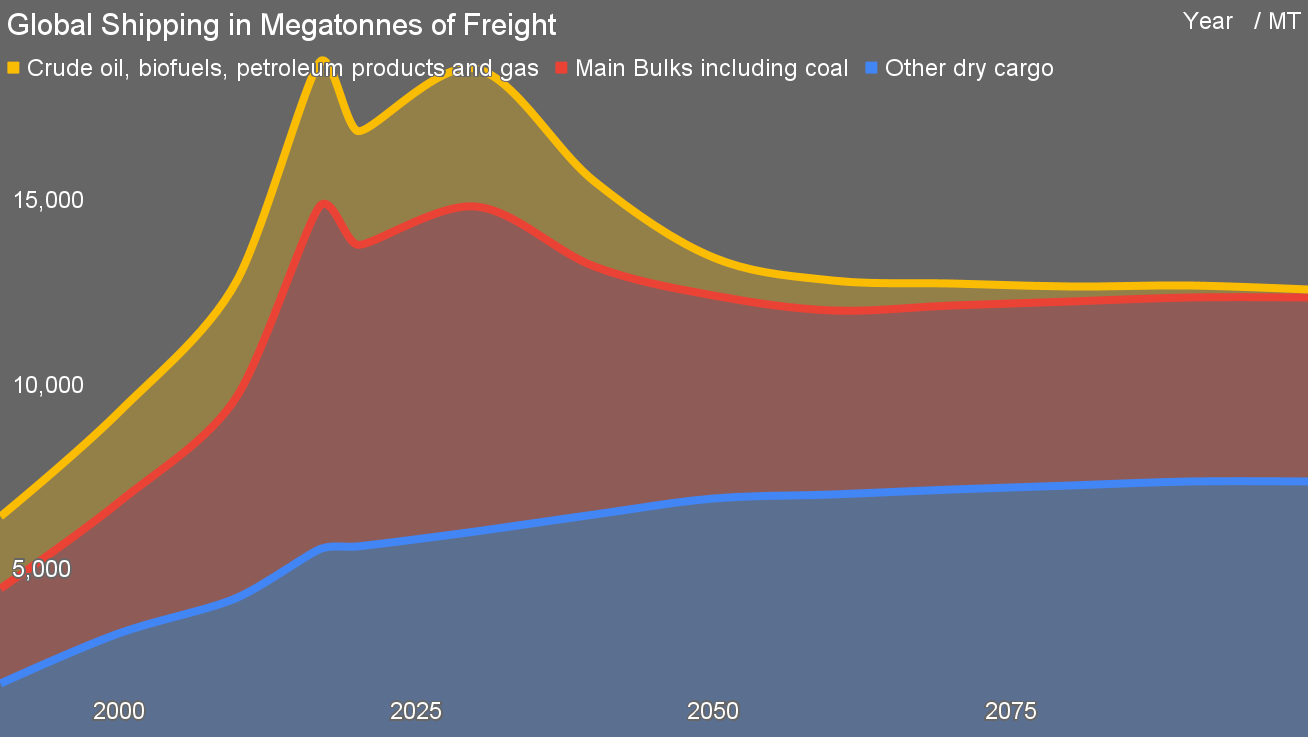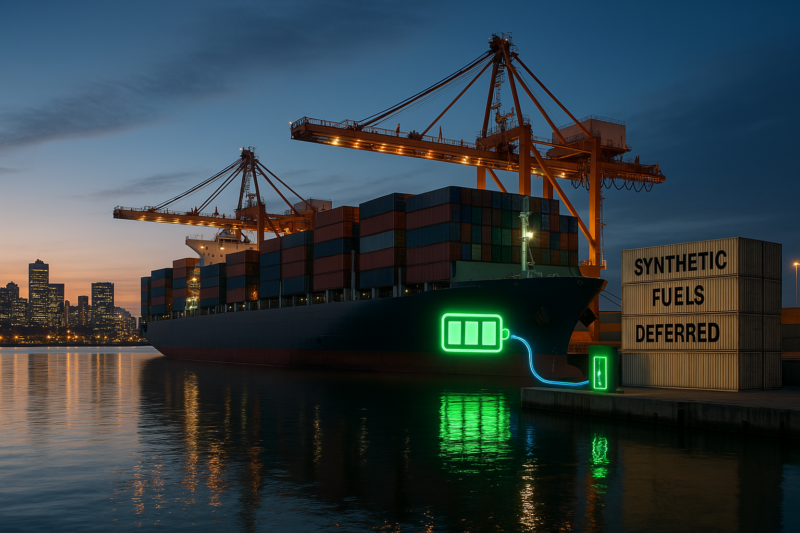Sign up for CleanTechnica’s Weekly Substack for Zach and Scott’s in-depth analyses and high level summaries, sign up for our daily newsletter, and/or follow us on Google News!
In April 2025, the International Maritime Organization did something rare for a UN body: it passed a binding climate policy. Not advisory, not aspirational, but actual mandatory rules. The agreement commits international shipping to net-zero greenhouse gas emissions “by or around 2050,” and despite the ambiguity of that phrasing, the intent is clear. The industry that accounts for roughly 3% of global CO₂ emissions is now officially on the clock. That’s not nothing. But before we break out the low-sulfur champagne, it’s worth unpacking what, exactly, this agreement commits to—and more importantly, what it ignores.
The strengths of the IMO agreement are obvious if you squint through the regulatory fog. It’s the first global climate mandate for an entire industry. It includes a global greenhouse gas fuel intensity standard, phased in from 2027, and a two-tiered carbon pricing mechanism that will penalize ships for emissions exceeding their annual allotment. At the lower tier, ships pay $100 per ton of CO₂ for moderate non-compliance. At the upper tier, that penalty jumps to $380 per ton. For a large vessel burning 100 tons of fuel per day and emitting roughly 3.1 tons of CO₂ per ton, that’s over $117,000 in fines per day of operation if they’re significantly over the benchmark. Over a 20-day trans-Pacific voyage, you’re staring down more than $2 million in carbon costs. That’s not a rounding error.
But the weaknesses are just as plain. The 2030 target—a 20% to 30% reduction in absolute emissions—is unlikely to be met, even with these rules, because the carbon pricing doesn’t bite until 2028. The agreement gives ships another three years of business-as-usual, precisely when cuts are most urgent.
Worse, the path to 2040 is a mystery. The current structure ends with 2035 fuel intensity targets, and the next set of rules won’t be decided until 2032. That means the trajectory to 70% emissions reduction by 2040 is based on policy that doesn’t yet exist.
And of course, the current four-year version of the United States walked out. The same country that was once pushing the IMO for stronger targets abruptly reversed course, reportedly calling the carbon levy “unfair to American shipping.” That’s rich, considering the U.S. barely has any international flag carriers left to be taxed and makes fewer commercial ships than either tiny Norway or fashion- and wine-giant Italy every year. The combination of the Jones Act, a fetishization of unregulated markets and zero interest in industrial policies for 45 years has led to the USA, once the biggest ship building country in the world, mostly building a few very, very expensive military ships.

What the IMO agreement fails to reflect is that the problem it’s trying to solve is shrinking. It’s based on legacy assumptions that shipping demand will continue to rise in step with global GDP, and that the only way to deal with emissions is to swap out fuels while keeping fleet size and cargo volumes constant. Their modeling is based on 40 or so people who apparently never heard of climate change projecting shipping volumes into the future based on 1990 to 2019 numbers. But that’s not what the real-world decarbonization trajectory looks like.
The most basic fact the IMO, or at least its preferred source material, doesn’t account for is that global trade in fossil fuels makes up nearly 40% of all seaborne tonnage. Coal, oil, gas—these aren’t just big emitters when burned; they’re big shippers. And in a decarbonizing world, they go away. Coal shipping collapses first, already down in key markets. Oil demand peaks in the 2020s. LNG persists longer but still declines before mid-century. That alone wipes out 40% of maritime volume. And that’s before considering the 15% of shipping currently devoted to iron ore, much of which becomes obsolete when China stops building infrastructure and nations start making steel from recycled scrap in electric arc furnaces located near demand.
The IMO’s projection? Doubling of bulks through 2050. However, their target is zero before my projection gets there. Aggression is good sometimes.
When you strip out the declining fossil cargo, switch to electrified inland and coastal shipping, and introduce modest efficiency improvements, the remaining deep-sea shipping problem shrinks fast. In my 2022 projection, I estimated that by 2100, shipping emissions would plummet without relying on synthetic fuels or radical redesigns—just through declining fossil trade, electrification of sub-1,000 km routes, and a rational energy transition. The IMO, in contrast, has designed a zero-carbon regulatory apparatus to solve a problem multiples of the size of what will actually exist by mid-century. It’s planning to replace all bunker fuel, when in fact a lot of that demand is going away.
Which brings us to the solution that actually fits the scale of the remaining problem. If the goal is to decarbonize the remaining deep-water cargo routes, covering voyages longer than 2,000 km and vessels over 5,000 gross tons, the IMO agreement limit, then you don’t need e-methanol or ammonia for every ship. You need a battery on board, a tank of biodiesel, and some math. Let’s run it.
Start with the port and nearshore segments. For environmental and regulatory reasons, these are the zones most urgently in need of zero-emissions operation. A 200 nautical mile stretch from shore in each direction, 400 NM total, is enough to cover emission control areas (ECAs), port maneuvering, and loading and unloading windows. ECAs are zones designated by the IMO where ships must meet stricter limits on sulfur, nitrogen oxides, and particulate emissions to protect coastal air quality. There are currently four ECAs: the Baltic Sea, the North Sea, North America, and the U.S. Caribbean.
For a 5,000+ ton vessel using about 2.4 MWh per NM, you need roughly 960 MWh of battery capacity. At 300 Wh/kg LFP cells, that’s a battery weighing 3,200 metric tons. On a 60,000 DWT containership, that’s about 5% of payload. It’s a tradeoff, but not a dealbreaker. At $65/kWh, the latest LPF BESS price out of China’s auctions , the full battery costs ~$60 million. Assuming a 3,000-cycle life, it can be amortized over a 30-year vessel lifetime and contribute less than $20 per MWh delivered. The electricity to charge it at port? In countries with clean grids or dedicated renewables, figure $0.10/kWh, or ~$100,000 per voyage segment. Total nearshore energy cost: less than $300,000 per voyage. Zero local pollution. Zero carbon emissions. Zero future retrofit cost.
For the remaining 3,400 NM on a trans-Atlantic or 6,100 NM on a trans-Pacific route, the battery isn’t going to cut it. That’s where the fuel comes in. But it doesn’t need to be ammonia or e-methanol. It doesn’t even need to be fancy. It just needs to be biodiesel. At 42 MJ/kg and roughly 85% lower lifecycle GHG emissions than fossil marine gasoil, HVO biodiesel does the job. A ship burning 1,600 tons of biodiesel for the Atlantic or 2,900 tons for the Pacific pays about $1,100 per ton, or $1.8 to $3.2 million per trip. That’s more than fossil fuel, but not dramatically so—and it avoids $1.5 to $2.8 million in carbon fines at $380 per ton of CO₂. Better yet, it doesn’t require engine replacement, retrofitted bunkering tanks, or a multi-decade port fuel transition plan. It just goes in the same tank as before.
Biomethanol costs more, but may be required simply because—as chemical process engineer and plant designer Paul Martin points out when we discuss this—the molecules matter, and the molecules in biodiesel are somewhat limited, hard to make and absolutely required for long haul aviation. The numbers may crunch out to biomethanol being what ends up in much bigger fuel tanks for crossing oceans. Bigger because methanol has 45% the energy density of current bunker fuels.
Synthetic methanol, by contrast, costs about $1,400 per ton, and that energy density bites hard. For the same 6,100 NM trans-Pacific crossing, that’s 5,300 tons of fuel, or $7.4 million. You save the carbon penalty, sure, but you still pay more than double the biodiesel hybrid. Green ammonia is even worse: you need over 5,700 tons of fuel for the same trip, at $1,000 per ton, and you also need cryogenic or pressurized tanks, new combustion tech, and safety systems for a fuel that’s toxic, corrosive, and flammable in all the wrong ways. Ammonia’s only advantage is that it doesn’t contain carbon. But neither does logic, and logic says you don’t carry around three times the volume of a fuel that will kill the crew if you don’t have to.
What the IMO needs to do now is match policy to physics. The shipping sector is not going to decarbonize on a one-size-fits-all molecule. It’s going to decarbonize on fewer ships, fewer kilometers, and fewer tons of fuel. Most short-sea shipping will go electric. Inland shipping already is. Fossil cargo will vanish. Trade will regionalize. The long-haul shipping sector will shrink. And what remains can be served by batteries and biofuels for virtually all trips. That’s the map. Anything else is drawing zero-carbon lines on an evaporating ocean.
Whether you have solar power or not, please complete our latest solar power survey.

Have a tip for CleanTechnica? Want to advertise? Want to suggest a guest for our CleanTech Talk podcast? Contact us here.
Sign up for our daily newsletter for 15 new cleantech stories a day. Or sign up for our weekly one if daily is too frequent.
CleanTechnica uses affiliate links. See our policy here.
CleanTechnica’s Comment Policy

